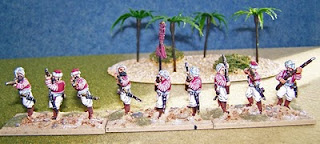The opposing forces were Napoleon's army of Egypt and their Mameluke opponents. I originally built up these armies for a series of display games at shows in 2008 and they featured in Wargames Illustrated in August of that year. We used Principles of War rules for the display games so it was interesting to use a different set of rules.
Napoleon had to march a cavalry brigade and two infantry brigades across the table whilst attacked by hordes of Mamelukes supported by Bedouin light horse. The outnumbered cavalry eventually crumbled but the infantry squares held firm. The rules played really well, particularly the special rules like 'determined charge' that required the Mameluke horse to attack the French whenever they came in charge range. Very impressed as it gave a really enjoyable game.
The inspiration for the orignal game was Charles Grant's books on the campaign and in particular Bob Marrion's artwork. One of my projects for this year is to develop the British forces for the later stages of the campaign. The paintbrush awaits.......







